When songbirds usually prefer mountains and forests, do Nebraska’s great prairies hold any interest for them? As it stands, you can find up to 9 different finch species!
Now, finches are some of the most curious and adaptable songbirds around. While dense forests hold a lot of appeal for them, they’ll still thrive in flat and dry environments.
In fact, some of the finch species in this list are big fans of farmlands. Fortunately for them, Nebraska is over 90% farmland!
If Nebraska is your next bird-watching location, I have some tips for you. Below you’ll learn about the most common (and a few uncommon) finch species by their appearance, birdsong, and more.
Rose-Breasted Grosbeak
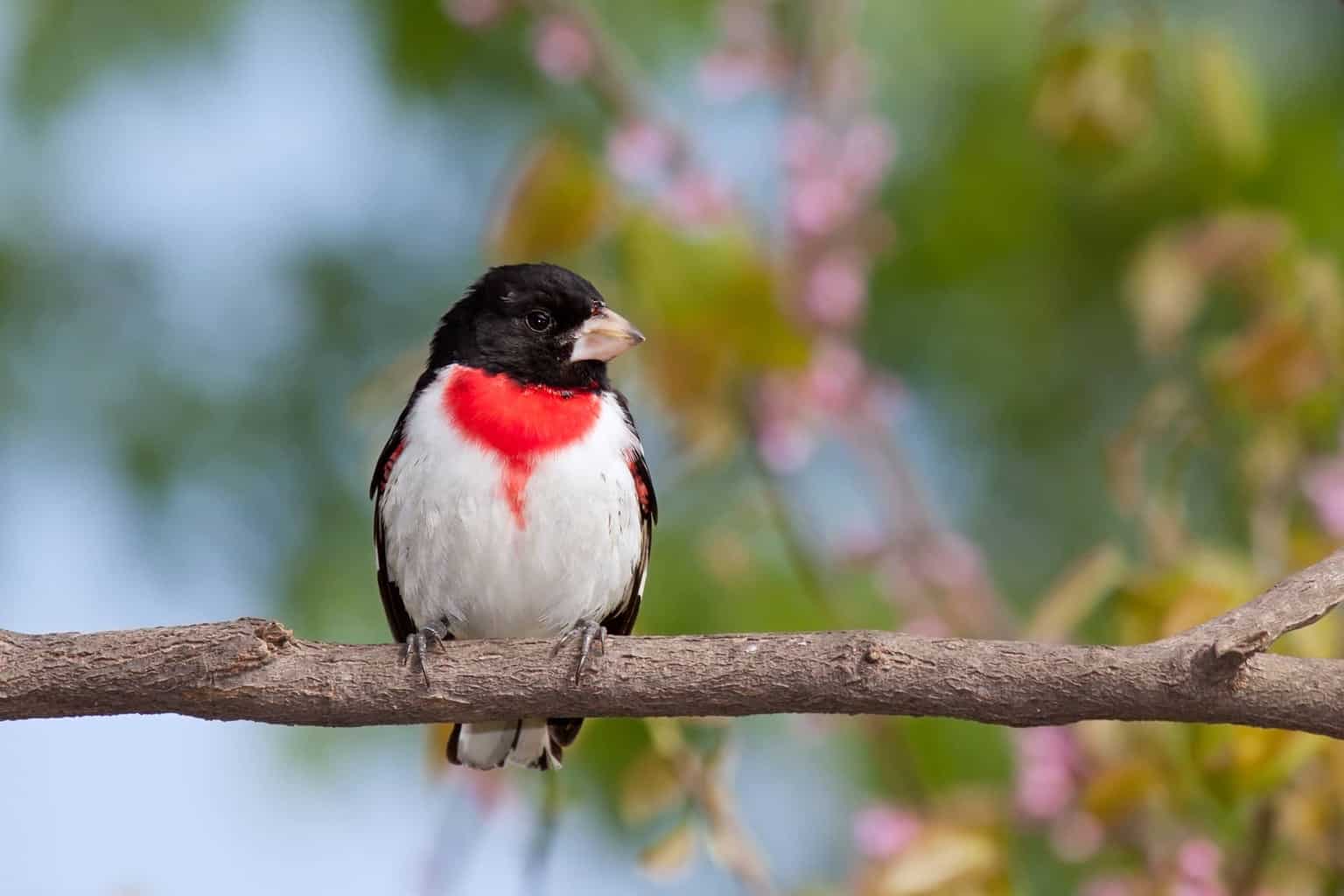
- Species Name: Pheucticus ludovicianus
- Length: 18 cm to 22 cm
- Weight: 35 grams to 65 grams
- Wingspan: 29 cm to 33 cm
Let’s start off this journey through Nebraska with one of the most recognizable finch species. This bird has plumage so vivid, they look more well-suited to a jungle than a dry prairie.
Appearance
The male rose-breasted grosbeak is a spectacular bird, covered in bold black with a white belly and speckled white wing bars. His most notable feature is his cherry red throat and chest.
The female rose-breasted grosbeak looks quite different – you might just confuse her for a sparrow species! She has a light brown body with a speckled stomach and white ‘eyebrow’.
You’ll also notice her bill is a vivid pink.
Range
These gorgeous birds usually show up in the eastern portion of the state during breeding season. However, they sometimes pass through the northern portion during migration.
Rose-breasted grosbeaks enjoy somewhat spacious areas like forest edges, parks, and gardens. As such, the flatter landscape of Nebraska is still pretty appealing to them.
If you feel like going on a long trip through one of the state’s parks, I recommend Spring Creek Prairie Audubon Center for spotting rose-breasted grosbeaks. You’ll also spot a few wrens!
Diet
While some birds prefer to eat in the trees, rose-breasted grosbeaks usually forage along the ground. They eat a diverse diet of seeds, insects, berries, and occasionally nectar.
If you want to stay at home and enjoy some birding from your window, try attracting them with sunflower seeds or peanuts. You’ll have greater luck using a platform feeder since these stocky finches usually shy from tube feeders.
Birdsong
This finch has a lovely and dynamic call. They’ll sometimes let out light, airy whistles, then switch to a complex warble.
Fun Fact
Fashion can sometimes be a little tiring! While the male rose-breasted grosbeak has a vivacious look most of the year, his plumage will fade during the fall months.
His black feathers will become more gray and his chest more pinkish.
Black-Headed Grosbeak
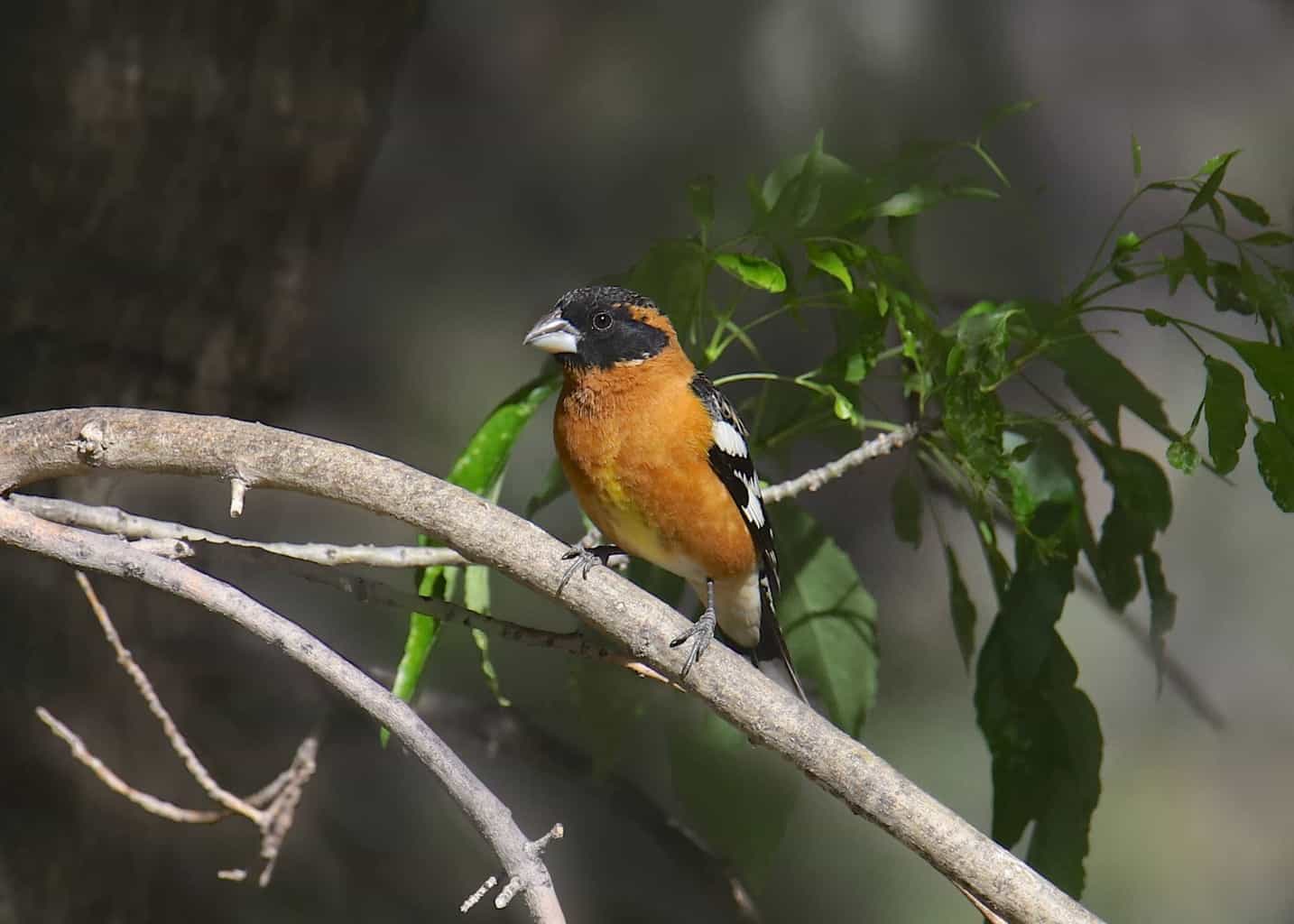
- Species Name: Pheucticus melanocephalus
- Length: 18 cm to 19 cm
- Weight: 34 grams to 48 grams
- Wingspan: 32 cm
With a larger size and striking coloration, the black-headed grosbeak may appear to be hawk-like at a glance. However, they still have the characteristic conical beak of the finch family.
Appearance
The male black-headed grosbeak is a lovely specimen to behold, boasting a bold black head and cinnamon-orange body. His black wings are speckled with white like he’s been sprinkled with paint.
The female black-headed grosbeak looks similar to the male, but with more faded plumage. She also has a thick white streak along her head.
Range
These finches tend to show up in the western portion of the state when the breeding season rolls around. They’re very scarce in the east part of the state, so you’ll have to do a little traveling to see them in any great number.
These stocky birds really show how adaptable this species is, showing up in just about any environment you can imagine. While they favor forested areas, they’ll also show up in suburban areas and shrubby fields.
Diet
A major reason why this bird is so adaptable is their diet. Black-headed grosbeaks will enjoy fruits, berries, seeds, spiders, and snails throughout the year.
Sunflower seeds are your safest bet to invite them to your feeder during the spring. If you have a nectar feeder, they may also take a sip!
Birdsong
Black-headed grosbeaks have a sweet, jaunty warble that sometimes transitions into long whistles.
Fun Fact
These birds have quite an impressive lifespan in captivity. While they usually only hit six or seven years in the wild, captive birds can live up to twenty-five years!
Pine Siskin
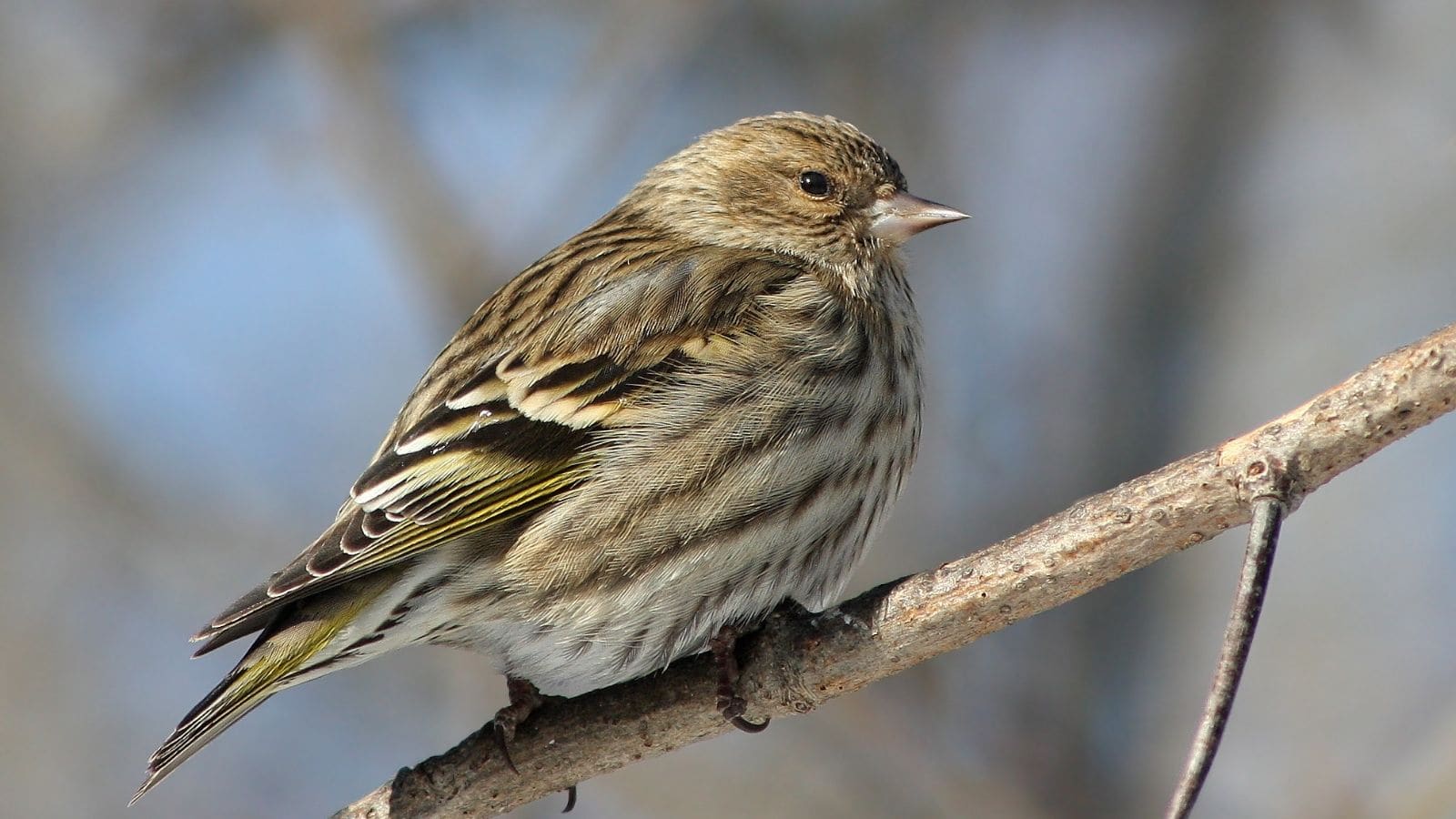
- Species Name: Spinus pinus
- Length: 11 cm to 14 cm
- Weight: 12 grams to 18 grams
- Wingspan: 18 cm to 22 cm
This cute little finch will really train your bird-watching eye. Their small size, flecked plumage, and small beak make them hard to spot for several reasons.
Appearance
The male pine siskin has a light yellow-brown body with darker wing bars and a speckled belly. You’ll see hints of yellow along the sides of his wings as well as his tail.
The female pine siskin looks nearly identical to the male but with less yellow.
Range
Nebraska has hardly any forests, yet this finch species will still pop up from time to time. You’ll often see them during nonbreeding season in the state’s wooded or shrubby areas.
While these finches prefer coniferous and mixed forests for their main food supply, they also like to visit backyard bird feeders.
Diet
Pine siskins eat a hearty diet of vegetable matter and seeds. They’re particularly fond of dandelions, of which Nebraska has plenty.
If you want to attract these birds, try stocking up on thistle or sunflower seeds during the winter. Since their beaks are smaller, they can’t do larger seeds like safflower.
Birdsong
This bird is not just cute, they’re downright adorable. Their joyful song is a shrill and excited tzweeeee with a buzzing series of notes.
Fun Fact
These birds are not just tough to spot, they’re also tough to identify! Their speckled plumage and thin, tiny beak make them look like sparrows.
Cassin’s Finch
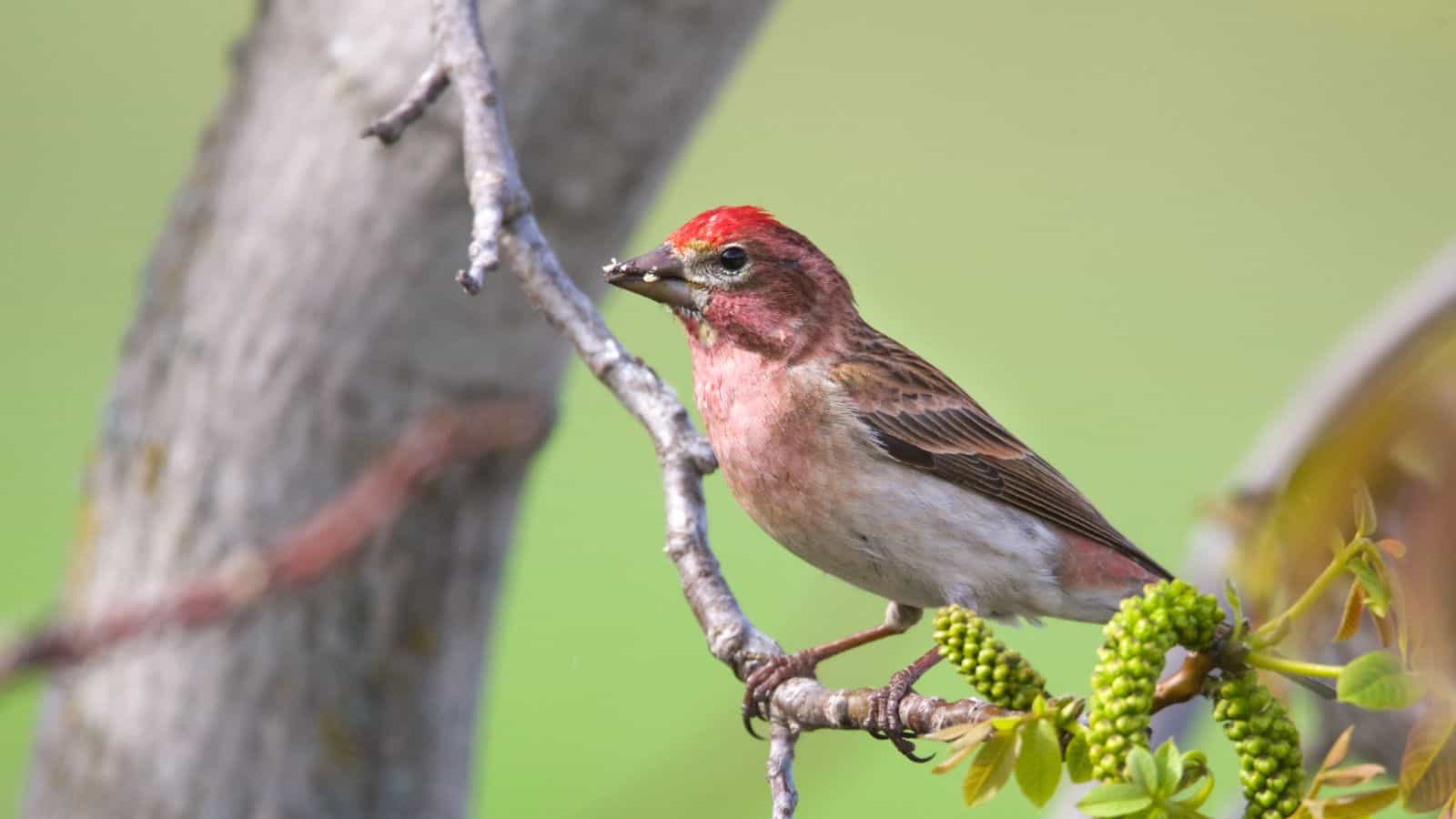
- Species Name: Haemorhous cassinii
- Length: 16 cm
- Weight: 24 grams to 34 grams
- Wingspan: 25 cm to 27 cm
While not the most common finch seen in the state, they have a tendency to show up during the frigid winter months. If you’re a backyard birder with a well-tended feeder, you could give these hard-working birds a break!
Appearance
The male Cassin’s finch is a rosy bird, boasting a reddish head and pink chest. They have brown bodies with darker wing bars and a white rump.
The female Cassin’s finch looks very similar to a female Purple Finch, so go easy on yourself if you mix them up. She has a light brown body with a flecked stomach and a long, pink-gray bill.
Range
These birds are rarer in the state due to their preference for coniferous forests. However, they’ll roam around quite a bit during winter due to dwindling food supply, so keep an eye out!
Diet
The Cassin’s finch is quite the foodie, mixing up their diet with berries, seeds, and flower buds. They’ll also eat the occasional insect, particularly moths.
You may be able to attract these birds during the winter with sunflower seeds. They’re also fond of fruit, so consider leaving out a few apple slices.
Birdsong
Not only does this bird look similar to a few other finch species, they even sound similar! The Cassin’s finch has a tendency to mimic other birds, so they can let loose warbles, chirps, or trills at random.
Fun Fact
Sometimes it amazes me how unique different animal species are. While a human child may start walking after one or two years, the Cassin’s finch will learn to fly after two weeks.
House Finch
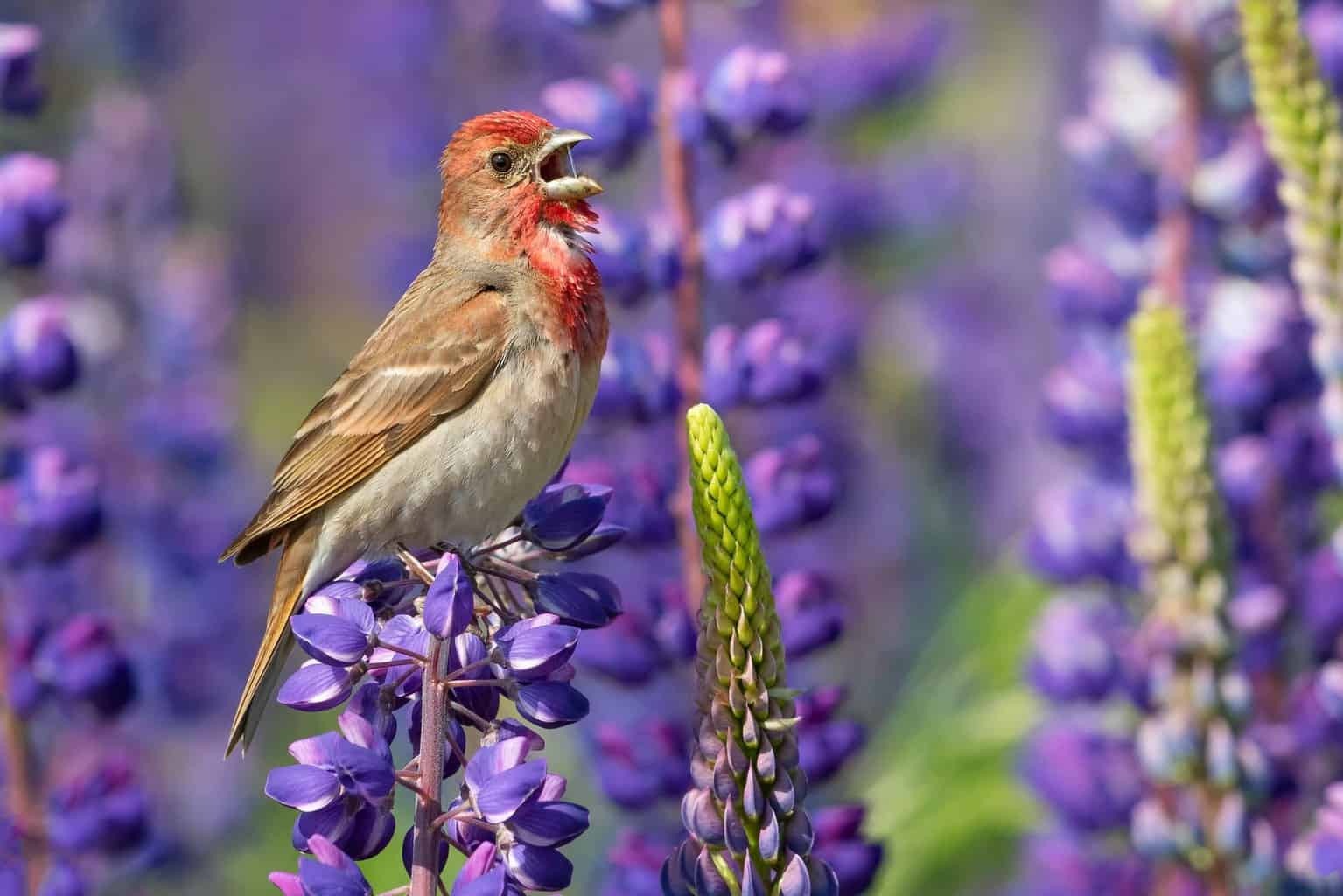
- Species Name: Haemorhous mexicanus
- Length: 13 cm to 14 cm
- Weight: 16 grams to 27 grams
- Wingspan: 20 cm to 25 cm
The Cassin’s finch is easy to get mixed up with the house finch due to similar coloration. However, this species is far more widespread and much more assertive.
Appearance
The male house finch has an intense, rosy head and throat with a brown body. He’s much more sleek than the Cassin’s finch and lacks the pale belly.
The female house finch is a light gray-brown with a speckled body and a pale gray bill. Compare this to the female Cassin’s finch which usually has a pinkish bill.
Range
They’ve earned their place as one of the most common finches by showing up all over the United States. This widespread finch species often shows up in pockets around the eastern portion of Nebraska.
While house finches sometimes visit weedy fields or forest edges, they commonly crop up in suburban areas. They love visiting parks, backyards, and occasionally busy neighborhoods.
Diet
While house finches may eat insects once in a while, they usually prefer plant matter. These birds eat a blended diet of seeds, fruits, berries, and flower buds.
Since these birds are so fierce and assertive, they’re quick to call dibs on any nearby bird feeders. You can try attracting them with thistle or safflower seeds, though be mindful they might fight off other birds!
Birdsong
House finches have melodious songs of loose, breezy warbles and chatty twitters. They’re one of those birds that honestly sounds like a person chatting over the phone.
Fun Fact
Female house finches are more likely to mate with males who have brighter heads and chests. This preference doesn’t make them shallow, but rather, helps them signify who’s healthy and fit enough to start a family.
Purple Finch

- Species Name: Haemorhous purpureus
- Length: 12 cm to 16 cm
- Weight: 18 grams to 32 grams
- Wingspan: 22 cm to 26 cm
Last but not least, we have the similar purple finch in our tricky bird trio! Purple finches have a charming appearance that’s a little easier to tell apart once you hone in on their stomach.
Appearance
The male purple finch has a rosy body with brownish wings and a bright white belly. This distinguishes him from the more earthy house finch and darker Cassin’s finch.
The female purple finch has a heavily flecked light brown body with a thicker white head stripe than the female Cassin’s finch. This also separates her from the female house finch, who has no head stripe.
Range
These adorable songbirds show up throughout most of the state during nonbreeding season. However, they’re rather scarce in the far west.
Purple finches are a little less common than other species on this list due to preferring more forested areas. When they do show up in Nebraska, it’s often because they’re foraging for food during the winter months.
Diet
Purple finches shake up their diet depending on the season. They love crunchy insects during the summer but switch to seeds during the winter.
Stock up on black oil sunflower seeds once it gets cold and stay patient. You’re bound to see a flock eventually!
Birdsong
The purple finch has a rich song of delicate warbles that often rise and rise in pitch. They tend to repeat their musical twittering song with a distinctive chwr-chwr-chwr-chweee.
Fun Fact
Not sure which feeder to use? The purple finch is responsive to both platform and tube feeders.
Lesser Goldfinch

- Species Name: Spinus psaltria
- Length: 9 cm to 11 cm
- Weight: 8 grams to 11 grams
- Wingspan: 20 cm
This rarer finch species is worth keeping an eye out for. Their incredibly small size and adorable song make them seem like little fairies.
Appearance
The male lesser goldfinch has a dark gray-black head and back with mottled white along his wings. His bright yellow belly and pale bill make for a striking contrast.
The female lesser goldfinch looks similar to the male but with more olive-yellow coloration. She also has no dark speckling around her head.
Range
Although not a common sight, these birds occasionally show up in western Nebraska during breeding season. They prefer smaller tree clusters and shrubby areas over dense forests.
If you feel like going on a long, scenic drive through Nebraska’s heartlands, keep an eye out for weedy fields
Diet
The lesser goldfinch’s diet is also quite tiny, mostly composed of weed seeds, little flower buds, and berries.
These birds are keen to visit feeders whenever they get the chance, so stock up on sunflower seeds or thistle. Since larger birds may try to scare them off, stick to tube feeders.
Birdsong
These birds have long, soaring calls of tweets and whistles. They often have long pauses in between.
Fun Fact
This finch might just be the smallest in the finch family, hence its (rather unflattering) name!
Red Crossbill

- Species Name: Loxia curvirostra
- Length: 20 cm
- Weight: 40 grams to 53 grams
- Wingspan: 27 cm to 29 cm
Nebraskan winters are no joke since the state lacks trees to push back against the frigid winds. Go figure, this is the kind of weather that red crossbills love the most!
Appearance
Adult males have a rusty red body with dark gray wings and thin white wing bars. His dark, criss-crossed beak isn’t an overbite – it’s a unique adaptation to a primary food source.
The female red crossbill has a light gray body with patches of faded yellow on her stomach and rump. Her criss-crossed bill is often lighter in color than the male’s.
Range
Since these birds prefer coniferous forests, they’re a rare sight in Nebraska’s flat terrain. However, they’ll quickly pack their bags and move when food runs out in the winter!
Diet
These birds not only enjoy eating conifer seeds, they’ll sometimes lick along the roadsides for salt. They also eat the occasional flower bud or insect if they’re low on options.
You have a higher chance of attracting these birds if you have a variety of food. Try mixing up safflower seeds, peanuts, and suet once it gets cold.
Birdsong
These finches have a bright, chirping call that dissolves into sparse chips or brief trills.
Fun Fact
Unlike other finches, these birds will breed whenever there’s a ready food supply. Yes, that means they’ll even have babies during the height of winter!
American Goldfinch

- Species Name: Spinus tristis
- Length: 11 cm to 13 cm
- Weight: 11 grams to 20 grams
- Wingspan: 19 cm to 22 cm
Is it any wonder why these finches are so popular? They’re small, and cute, and often bring a ton of friends with them to bird feeders.
Appearance
The male American goldfinch has a vivid yellow body, black wings, and a jet-black cap. His wings often have speckled rows of white that lead into his tail.
The female American goldfinch has a more olive-yellow body with similar wing patterns to the male. However, she doesn’t have a black cap.
Range
These birds are comfortable in a variety of environments ranging from small woodlands to your backyard. They show up throughout the state all year long but are a little more common during the summer.
Diet
These beautiful finches generally prefer seeds, whether it’s from weeds or trees. They’re particularly fond of alder, elm, and birch.
If you want to attract these birds to your feeder, stock up on sunflower or thistle seeds. You’ll have a veritable party to watch when they invite over a whole flock!
Birdsong
These sociable birds let loose jaunty, happy warbles that make it clear why they’re part of the songbird classification. Expect to hear chwee-er-chwee-er patterns.
Fun Fact
These birds may be beloved in the finch family, but they can still look similar to warbler species. Keep an eye out for their characteristic thick conical bill.
Nebraska Is a Lovely Spot for a Little Bird Watching
If you’ve got an itching for birdwatching in Nebraska, you have more options than you realize. Finch species enjoy stepping off the beaten path and will happily visit flatlands and plains in search of a new meal!
If you enjoy long drives, keep an eye out for shrubby areas where pine siskins or black-headed grosbeaks are foraging. I also recommend swinging by state parks like the Spring Creek Prairie Audubon Center for a front-row seat to rose-breasted grosbeaks.
Backyard birders have an advantage here since many finches prefer to pass through the state during winter for easy meals.
Wondering what other birds can you spot in Nebraska? We’ve got a Birds in Nebraska guide with your name on it!

